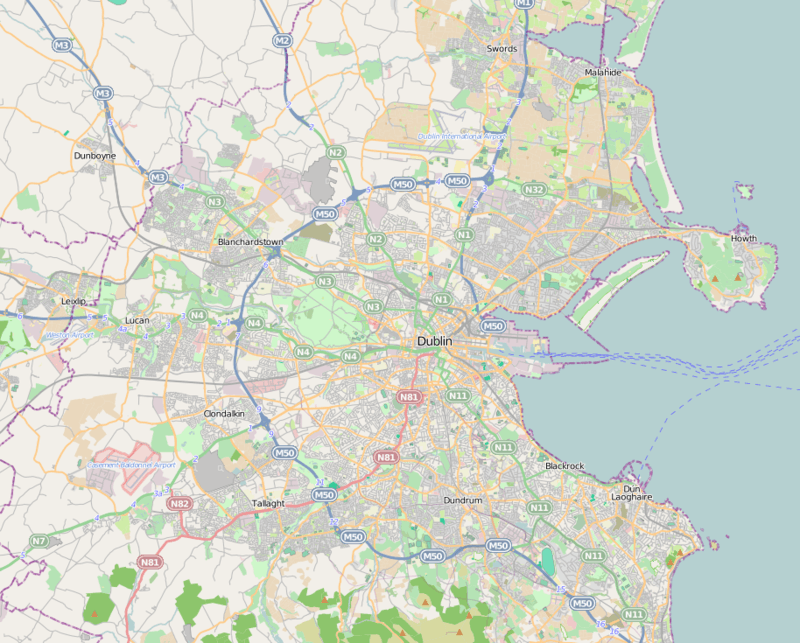St. Wolstan's Priory
St. Wolstan's Priory is a former Augustinian (Victorine) monastery located in County Kildare, Ireland.[2]
Prióireacht San Ualstain[1] | |
 Location within Dublin  St. Wolstan's Priory (Ireland) | |
| Monastery information | |
|---|---|
| Other names | Scala Caeli |
| Order | Victorines |
| Established | 1202/05 |
| Mother house | Abbey of Saint-Victor, Paris |
| Diocese | Dublin |
| People | |
| Founder(s) | Adam de Hereford |
| Architecture | |
| Status | ruined |
| Style | Norman |
| Site | |
| Location | St. Wolstan's, Celbridge, County Kildare |
| Coordinates | 53.343605°N 6.517151°W |
| Visible remains | two gateways, tower |
| Public access | No |
Location
St. Wolstan's Priory is located on the eastern edge of Celbridge, on the south bank of the River Liffey; it lies 1 km (0.62 mi) southeast of Castletown House and about 1.8 km (1.1 mi) east-northeast of Celbridge's Main Street.
History
The priory was founded in 1202 (or, according to William of Ware, 1205) by Adam de Hereford, one of the Anglo-Norman leaders of the Norman conquest of Ireland. It was founded for canons of the order of St Victor and was named after the recently canonised Saint Wulfstan (died 1095). The early buildings were nicknamed Scala Coeli, "stairs of heaven."[3]
The monastery was granted the lands around Donaghcumper Church. In 1271 William de Mandesham, seneschal to Fulk Basset, Archbishop of Dublin, granted to the priory the lands of Tristildelane, modern Castledillon.
In 1308 a bridge across the River Liffey was built by John Ledleer next to the gate of St. Wolstan's.[4] In 1314 the churches of Stacumney and Donaghmore were granted to the sole and separate use of the prior.
In 1536 the priory and lands were seized by King Henry VIII as part of the Dissolution of the Monasteries. It was the first monastery in Ireland to be suppressed and the last prior, Richard Weston, was granted a room in the monastery and supplied with food and fuel for the rest of his life.[5] It was granted to John Alan in 1538.
The buildings of the priory were probably converted into a house for Sir John Alan before his death in 1561.[6] The Alen family lived at St. Wolstans for 216 years. They resided in the priory for much of this period and later built the house.[5]
In 1782 the ruins were visited and sketched by Austin Cooper (1759–1830).[7]
In 1955 the site was purchased by the Holy Faith Sisters, who established St. Wolstan's Holy Faith Convent School. The school has since moved site but retains the name of St Wolstan's Community School.
It was partially excavated in 2002 as part of an archeological assessment, but nothing of significance was found.[8]
References
- https://www.logainm.ie/en/25365
- "Enforcing the English Reformation in Ireland: Clerical Resistance and ... - James Murray - Google Books". Books.google.ie. 2011-07-21. Retrieved 2020-01-15.
- "St Wolstan's by William Kirkpatrick (1896) | Ardclough Community Council". Ardclough.wordpress.com. 2019-10-05. Retrieved 2020-01-15.
- "A Topographical Dictionary of Ireland - Samuel Lewis - Google Books". Books.google.ie. Retrieved 2020-01-15.
- By: Mick @ MBE (2014-06-06). "Ruins of St Wolstans Monastry | Adam de Hereford, a Norman K…". Flickr. Retrieved 2020-01-15.
- "1730s – St Wolstan's, Celbridge, Co. Kildare – Archiseek – Irish Architecture". Archiseek.com. Retrieved 2020-01-15.
- "Holdings: Ruins of the Priory of St: Wolstan, Co:y Kildare". Catalogue.nli.ie. Retrieved 2020-01-15.
- "8205 « Excavations". Excavations.ie. Retrieved 2020-01-15.
- "St Wolstan's Priory, Co. Kildare: this four-storey tower has also undergone major renovations | The Discovery Programme - Europeana Collections". Europeana.eu. Retrieved 2020-01-15.